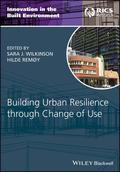Building Urban Resilience through Change of Use
Innovation in the Built Environment

1. Auflage April 2018
256 Seiten, Hardcover
Wiley & Sons Ltd
Describes all aspects of sustainable conversion adaptation of existing buildings and provides solutions for making urban settlements resilient to climate change
This comprehensive book explores the potential to change the character of cities with residential conversion of office space in order to withstand the negative effects of climate change. It investigates the nature and extent of sustainable conversion in a number of global cities, as well as the political, economic, social, technological, environmental, and legal drivers and barriers to successful conversion. The book also identifies the key lessons learned through international comparisons with cases in the UK, US, Australia, and the Netherlands.
Building Urban Resilience Through Change of Use covers the benefits and aspects of sustainable conversion adaptation through the whole lifecycle from inception, planning, and design, to procurement, construction, and management and operational issues. It illustrates and quantifies, through empirical research, the changes that have been achieved or delivered in sustainable conversion adaptation. The book gives an overview of all aspects of performance characteristics and the conversion adaptation of existing buildings. In the end, it enables planners to make more informed decisions about whether conversion adaptation is a good choice--and if so, which types of sustainability measures are best suited for projects.
* Provides detailed, empirical knowledge based on real-world research undertaken in five countries over three continents on both a citywide scale and on individual buildings
* Case studies and exemplars demonstrate the application of the knowledge in North and South America, Canada, Australia, New Zealand, and in Europe
* Addresses the key themes of technology, finance and procurement, and the regulatory framework
The first research-based book to examine how to improve resilience to climate change through sustainable reuse of buildings, Building Urban Resilience Through Change of Use is a welcome book for researchers and academics involved in building surveying, urban development, and sustainability planning.
Contributor Biographies xi
Acknowledgements xv
Foreword: Resilience as a 'Lens' for Driving the Adaptive Capacity of Cities xvii
Chapter 1 The Context for Building Resilience through Sustainable Change of Use Adaptation 1
1.1 Introduction 1
1.2 Scale of the Problem: From City to Building Scale 4
1.3 Definitions of Key Terms 6
1.4 Background and Scope 8
1.5 The Notion of Urban Resilience 9
1.6 Synopsis 13
1.7 Summary 17
References 18
Chapter 2 Precinct?]scale Innovation and the Sharing Paradigm 21
2.1 Introduction 21
2.2 The Emergence of the Sharing Paradigm 24
2.3 Potential Benefits of the Sharing Paradigm for Cities and Precincts 25
2.4 How Building and Land Conversions Could Help Enable the Sharing Paradigm 27
2.5 Conclusions: Sharing the City 35
References 36
Chapter 3 Planning Policy Instruments for Resilient Urban Redevelopment: The Case of Office Conversions in Rotterdam, the Netherlands 39
3.1 Introduction 39
3.2 Conceptual Planning Policy Instruments 41
3.3 Planning Policy Instruments in Rotterdam 46
3.4 Classifying and Evaluating Policy Instruments in Rotterdam 51
3.5 Conclusions 54
References 54
Chapter 4 Adaptation and Demolition in a Masterplan Context 57
4.1 Introduction 57
4.2 Literature Review 58
4.3 Methodology 64
4.4 Analysis 67
4.5 Conclusion 75
4.6 Planned Continuation of Research 77
References 78
Chapter 5 Sustainable Design and Building Conversion 83
5.1 Introduction 83
5.2 Durability: Measuring 'Long Life' 85
5.3 Adaptability: Measuring 'Loose Fit' 86
5.4 Sustainability: Measuring 'Low Energy' 88
5.5 Case Studies 89
5.6 A Framework for Evaluation of Urban Renewal Projects 91
5.7 The Application and Implications of Life Cycle Costing 99
5.8 Conclusion: Implications for Future Practice 100
References 102
Chapter 6 Top?]up: Urban Resilience through Additions to the Tops of City Buildings 105
6.1 Introduction 105
6.2 Top?]up Context 105
6.3 Top?]up Typology 108
6.4 Top?]up and Heritage 109
6.5 Case Studies 111
6.6 Urban Resilience 115
6.7 Conclusion 118
References 118
Chapter 7 Conversion Potential Assessment Tool 121
7.1 Introduction: Why Adaptive Reuse? 121
7.2 Opportunities and Risks 122
7.3. Conversion Meter 126
7.4 Conversion Meter Case Studies 142
7.5 Lessons Learned from Case Studies 143
7.6 Concluding Remarks 148
7.7 Next Steps 148
References 149
Chapter 8 Rating Tools, Resilience and Sustainable Change of Use Adaptations 153
8.1 Introduction 153
8.2 Sustainability in Building Adaptation: Drivers and Barriers 154
8.3 Leading Rating Tools and Conversion Adaptation 156
8.4 Resilience Challenges 168
8.5 Conclusions 171
References 172
Chapter 9 Conclusions on Building Resilience through Change of Use Adaptation: A Manifesto for the Future 175
9.1 Introduction 175
9.2 Overview of Resilience Issues, Sustainability and Change of Use Adaptation 175
9.3 Qualities of Resilient Systems in the Context of Conversion Adaptation 182
9.4 Resilience and Sustainable Conversion Adaptation 183
9.5 The Manifesto for Sustainable and Resilient Conversion Adaptation 184
9.6 Moving Forward 185
9.7 Conclusions 186
References 187
Appendix 9.A Checklists for Building Resilient Cities though Sustainable Change of Use 188
Index 193
SARA J. WILKINSON, BSc, MA, MPhil, PhD, FRICS, AAPI, is an Associate Professor at the University of Technology Sydney. Working at the intersections of sustainability, resilience, building adaptation and transformation, her research aims to improve local, national and international outcomes of urban development in respect of: climate change and a growing urbanised population. Sara practiced for several years in the public and private sectors. She engages in trans-disciplinary research with colleagues from science, health, business, technology and built environment, publishing over 150 outputs including books, research reports, journal and conference papers. She contributes to the surveying profession through national and international committees, accreditation and APC assessment.
HILDE REMØY, PhD, MSc, is Associate Professor in Real Estate Management at the Faculty of Architecture and the Built Environment of Delft University of Technology. After an international educational and professional path, including Norway, Italy, and the Netherlands, she is now teaching, researching and writing (over 100 publications) on office vacancy, sustainable building adaptation and conversion. In this work, sustainability, resilience, lifespan and continued re-use of historic buildings are the main points. Hilde is involved in research ranging from large scale European funded projects to contract research for Dutch practice, working with researchers and professionals of various disciplines and backgrounds.


